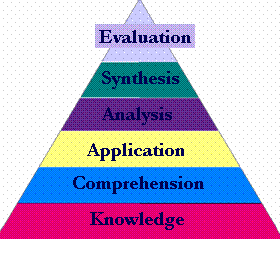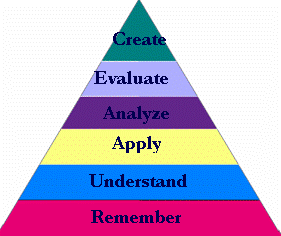 |
Taxonomies of Learning |
 |
| Bloom's
(1956) |
Anderson
& Krathwohl's (2000) |
R I S I N G C O G N I T I V E D E V E L O P M E N T |
||||||||||||||||||||||
| Competence - Knowledge |
Remembering | |||||||||||||||||||||||
Remembering or retrieving previously learned material. Examples of verbs that relate to this function are: |
Retrieving, recalling, or recognizing: knowledge from memory. Remembering is when memory is used to produce definitions, facts, or lists, or recite or retrieve material. | |||||||||||||||||||||||
|
||||||||||||||||||||||||
| |
||||||||||||||||||||||||
| Competence - Comprehension |
Understanding |
|||||||||||||||||||||||
| The ability to grasp or construct meaning from material. Examples of verbs that relate to this function are: | Constructing meaning from different types of functions be they written or graphic messages activities like:
|
|||||||||||||||||||||||
|
||||||||||||||||||||||||
| Competence - Application |
Applying |
|||||||||||||||||||||||
| The ability to use learned material, or to implement material in new and concrete situations. Examples of verbs that relate to this function are: | Carrying out or using a procedure through executing, or implementing. Applying related and refers to situations where learned material is used through products like:
|
|||||||||||||||||||||||
|
||||||||||||||||||||||||
| Competence - Analysis |
Analyzing |
|||||||||||||||||||||||
| The ability to break down or distinguish the parts of material into its components so that its organizational structure may be better understood. Examples of verbs that relate to this function are: | Breaking material or concepts into parts, determining how the parts relate or interrelate to one another or to an overall structure or purpose. Mental actions included in this function are:
as well as being able to distinguish between the components or parts. When one is analyzing he/she can illustrate this mental function by creating spreadsheets, surveys, charts, or diagrams, or graphic representations. |
|||||||||||||||||||||||
|
||||||||||||||||||||||||
| Competence - Synthesis |
Evaluating |
|||||||||||||||||||||||
| The ability to put parts together to form a coherent or unique new whole. Examples of verbs that relate to this function are: | Making judgments based on criteria and standards through checking and critiquing. Critiques, recommendations, and reports are some of the products that can be created to demonstrate the processes of evaluation. In the newer taxonomy evaluation comes before creating as it is often a necessary part of the precursory behavior before creating something. This category has now changed places with the last one on Bloom's original list. |
|||||||||||||||||||||||
|
||||||||||||||||||||||||
| Competence - Evaluation |
Creating |
|||||||||||||||||||||||
| The ability to judge, check, and even critique the value of material for a given purpose. Examples of verbs that relate to this function are: | Putting elements together to form a coherent or functional whole; reorganizing elements into a new pattern or structure through generating, planning, or producing. Creating requires users to put parts together in a new way or synthesize parts into something new and different a new form or product. This process is the most difficult mental function in the new taxonomy. This category is what Bloom referred to as Synthesis |
|||||||||||||||||||||||
|
||||||||||||||||||||||||
| Visual
Comparison of the taxonomies |
|||||||||||||||||||||||||||||||||||||||||||
| Bloom (1956) |
Anderson and Krathwohl (2001) |
||||||||||||||||||||||||||||||||||||||||||
 |
 |
||||||||||||||||||||||||||||||||||||||||||
One of the things that differentiates the new model from that of the 1956 original is that it lays out components nicely so they can be considered and used. And while the levels of knowledge were indicated in the original work:
these were never fully understood or used by teachers because most of what educators were given in training consisted of a simple chart with the listing of levels and related accompanying verbs. The full breadth of Handbook I and its recommendations on types of knowledge were rarely discussed in any instructive way. Nor were teachers in training generally aware of any of the criticisms of the original model. The updated version has added "metacognitive" to the array of knowledge types. Here are the intersections as the processes impact the levels of knowledge. Using a simple cross impact grid or table like the one below, one can match easily activities and objectives to the types of knowledge and to the cognitive processes as well. |
|||||||||||||||||||||||||||||||||||||||||||
|
|||||||||||||||||||||||||||||||||||||||||||
Metacognitive Knowledge is the awareness of one's own cognition and particular cognitive processes. It is strategic or reflective knowledge about how to go about solving problems, cognitive tasks, to include contextual and conditional knowledge and knowledge of self.